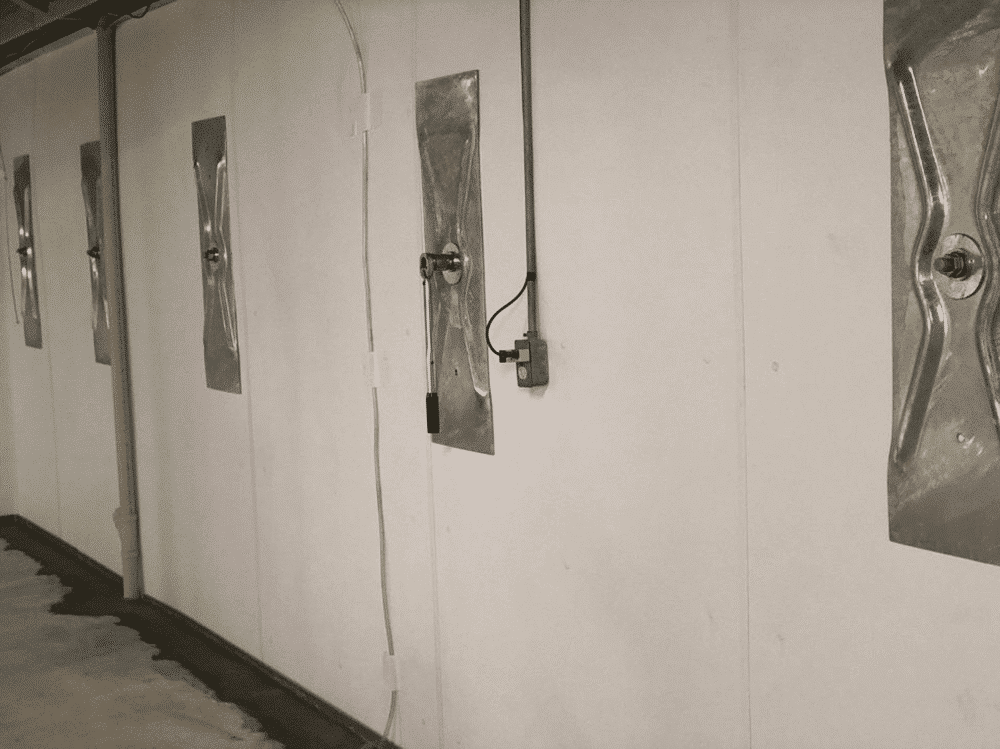
House hunting can be thrilling until you enter a basement with bowed walls. Leaning basement walls indicate underlying foundation issues that could compromise your safety and your investment in a new home. But don’t cross that property off your list just yet!
With the right information, you can turn this apparent dealbreaker into a good investment. In this guide, we’ll cover everything you need to know about bowing basement walls to make well-informed decisions.
What are Bowing Basement Walls, and How Serious Are They?
Bowing basement walls occur when the foundation walls curve or lean inward under external pressure instead of staying upright. This structural problem creates an uneven surface and can lead to cracks and water damage.
Appropriate repair methods depend on factors like the location of your home, the accessibility of your foundation, the degree of bowing, and how widespread the damage has become, but one thing’s certain: even slight inward bending must be professionally addressed since such problems never go away without intervention.
Risks of Bowing Basement Walls
Bowing basement walls come with several risks, including the following:
1. Structural Instability
Bowing walls are no longer in a position to bear the weight of your house properly. When walls are bowing, it is because the ground is pushing against your foundation walls until they start to bend and crack from the pressure.
A house may have other issues like sloping floors, sticking doors and windows, and moisture damage. A bowing basement wall is dangerous because the movement can eventually lead to major structural failure. The longer the problem continues, the more extensive the repairs will be.
2. Water Damage
When walls bow and crack, water can enter your basement, especially during heavy rain. Damp conditions can create a musty smell and promote mold growth, which can cause serious health problems. Items stored in the basement, wooden supports, and finishes like drywall or carpeting can be permanently ruined.
If water continues to enter, it also weakens the foundation, further speeding up the bowing and risk of collapse. Moisture, if not addressed, can also lead to rust, wood rot, and electrical hazards, making the basement more unsafe.
3. Decreased Property Value
Houses with bowing foundation walls are sold for much less than similar houses with no foundation problems. A home inspector might also report the issue to the potential buyers, and the house will be difficult to sell at full price.
This is because they do not want to take on expensive structural repairs, and some will just walk away from the sale entirely or offer much less. Most banks will not offer loans for houses with serious foundation issues, so it’s harder to find qualified buyers.
Even after foundation repairs are completed, sellers are required to reveal prior foundation problems, which will make prospective buyers suspicious of long-term stability.
Causes of Bowing Basement Walls
Several factors can put stress on your foundation, causing it to weaken and bow inward. Here are five common reasons why this can happen:
1. Hydrostatic Pressure
Rain, melting snow, and groundwater can saturate the ground around your foundation, creating a powerful force that pushes against the basement walls. This force-hydrostatic pressure-increases where there are high groundwater levels. Even well-constructed foundations eventually yield to this persistent pressure, cracking and bowing inward as their integrity is undermined.
2. Expansive Soils
Clay soil expands dramatically when it’s wet and contracts when it’s dry, which leads to a damaging cycle around your home. When the soil is wet, the swelling soil unevenly lifts portions of your foundation. When dry weather returns, the soil shrinks and may create voids, causing different sections to settle at varying rates. This repeated movement generates pressure on your foundation, gradually pushing your walls inward while they struggle to maintain their original position against the constantly shifting earth.
3. Poor Drainage
Inadequate water management diverts water to your foundation instead of away from it. A clogged gutter system or an improperly sloped yard directs water toward your basement, soaking the surrounding soil.
Water that is trapped exerts constant lateral pressure that most foundations aren’t designed to endure. Clay soil complicates this issue by retaining water longer than other types of soil. Simply redirecting water through proper grading and functional gutters can significantly reduce this damaging pressure.
4. Structural Issues
Structural problems tend to manifest themselves as bowing basement walls years after a home is built. Insufficient reinforcement or low-quality materials cannot withstand normal pressure over time. Older homes typically have foundations built to less strict standards than modern building codes require.
In these cases, walls may bow inward as the supporting structure shifts. This is a major problem since your foundation supports your entire home, so proper construction techniques are required to guarantee long-term stability.
5. Frozen Soil
Freezing ground expands significantly, exerting intense pressure on basement walls. As the temperature changes, the soil constantly rises when frozen and settles when thawed, creating a seasonal stress cycle.
Each winter causes potential damage as the walls continue to deteriorate under this repeated cycle. Houses with weak foundations or loosely packed surrounding soil are most susceptible to these freeze-thaw cycles, especially if they are in colder climates.
Addressing Bowing Basement Walls
Bowing basement walls requires different solutions based on how bad the damage is. A professional foundation repair expert can assess the issue and recommend the best repair solution. Here are the most effective methods for solving this basement wall problem:
1. Carbon Fiber Reinforcement
For less than 2 inches of bowing, carbon fiber reinforcement is a non-invasive, inexpensive solution. This method involves attaching carbon fiber straps to the wall using epoxy, which strengthens the wall and helps to prevent new cracks from forming.
The straps provide structural support without the need for exterior excavation. For maximum effectiveness, voids in the wall need to be filled with polyurethane or epoxy first before applying the straps to form a complete reinforcement system.
2. Wall Anchors or Braces
When walls bow inward more than 2 inches, wall anchors are most likely the best option. Steel plates are attached to the interior wall and connected by long rods to anchors placed in the soil outside the foundation.
These anchors or braces push against the outward pressure of the soil and, over time, can actually pull the wall back to a straighter position. While this method requires room for excavation outside the home, it’s extremely effective for moderate to severe bowing.
3. Waterproofing and Drainage
If you have bowing walls in your basement, you may need to address moisture issues as well. Repairs such as improving the grading around the foundation, maintaining clean gutters, and installing drainage systems redirect water away from your basement walls.
A sump pump can also be installed to drain water being forced into the basement. Combining these measures with structural reinforcement prevents future bowing by managing water buildup.
Should You Buy a House With Bowing Basement Walls?
If you want to buy a house that has bowing basement walls, you must weigh the pros and cons. On the downside, structural instability, water damage, and costly repairs can devalue the house and put its safety at risk. However, if the issue has been professionally repaired or can be fixed with the right solutions, it may be a smart investment.
KC Waterproofing and Foundation Repair offers expert services, including wall anchoring, foundation inspection, and interior drainage systems. Our professional team will assess the damage and recommend effective repairs.
Schedule an inspection today and protect your home’s foundation before it’s too late!










